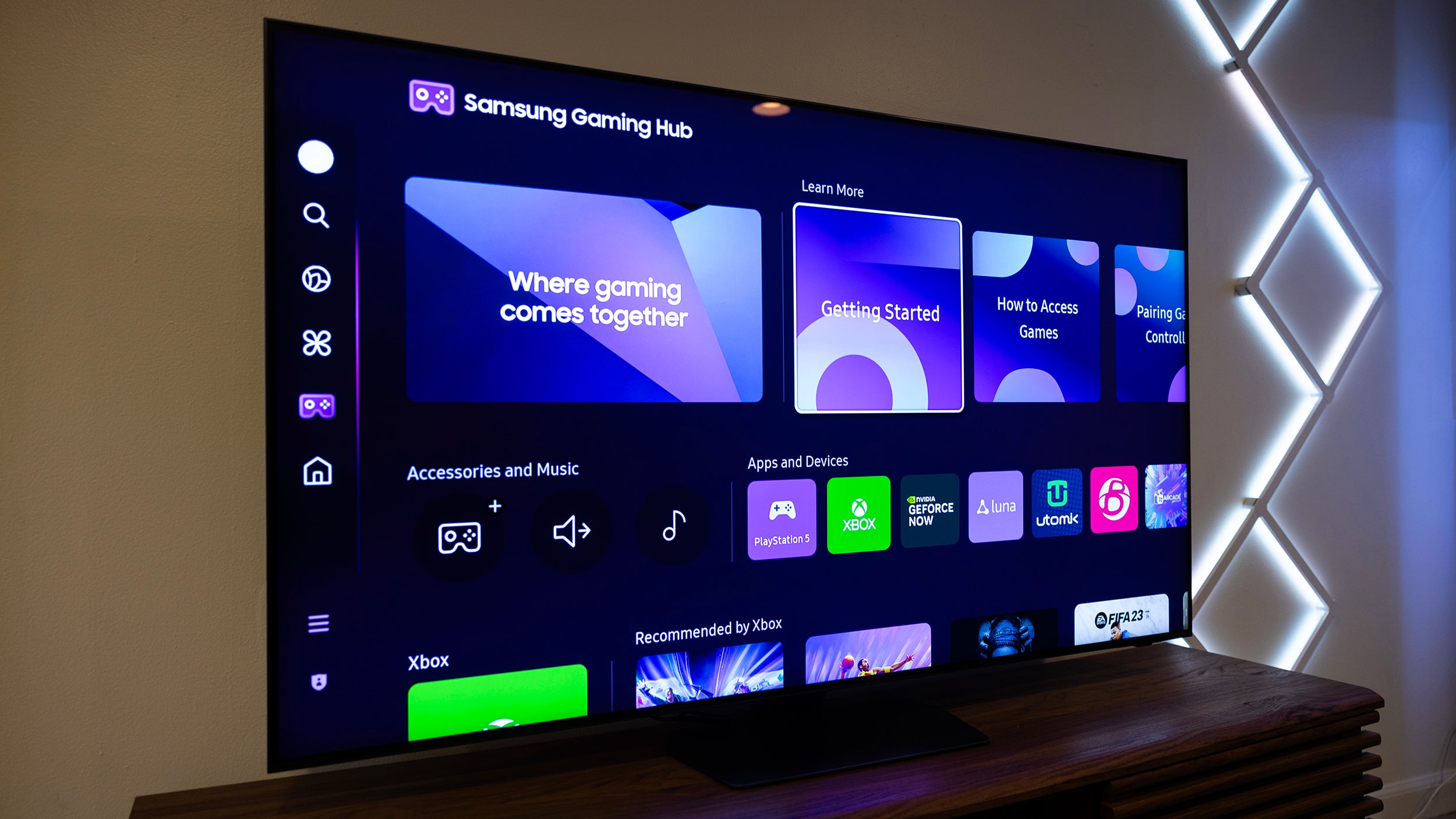Samsung, Sony, and LG all make excellent OLED televisions, but in the LCD space, brands like Hisense and TCL are nipping at their heels, making it more difficult to rationalize what is often a substantial premium.
That’s the market that Samsung and its QN90D finds itself in. If it’s going to ask buyers to fork over $2,700 for a new mini LED television, it needs to bring a lot more to the table than a brand name. To that end, Samsung put significant emphasis on improving the viewing experience of the QN90D by juicing the brightness without sacrificing color accuracy, refining the quality of the on-screen picture through several new technologies, and maintaining access to cloud gaming directly through the refreshed Tizen operating system.
A lot of these features look great on the side of the box but, luckily, they also improve the viewing experience in the living room too.
Samsung QN90D – Design and Build
Out of the box, the QN90D is very straightforward. The stand, should you choose to use it and not wall-mount your display, comes together quickly and easily with just a few screws. When orienting your cables, make sure to route the connections so that they reach the right side of the display, as all of the ports are over there except for the power source, which sits alone on the left side.
Samsung rarely skimps on connectivity and the QN90D features four HDMI 2.1 ports, none of which are labeled outside of one being recommended for gaming and one as eARC for HDMI-connected sound systems. All four support Auto Low Latency (ALLM), Variable Refresh Rate (VRR), and up to 4K at 144Hz.

The back of the TV also includes two USB-A connections, a LAN port, a cable input, and an optical audio output port. The QN90D also supports Bluetooth 5.2 and WiFi 5.
I really like the look of Samsung TVs, and the feeling continues here. The QN90D has very slim bezels that I hardly notice when watching TV and movies, and the stand in this case is simple, sturdy, and oriented directly below the center of the TV. I prefer this compared to the two-foot design seen on other TV designs, as it feels more secure and it’s easier to hide cables.
That last note is important because I would describe the cable management on the QN90D as only “fine.” While you can route the cables through the back of the stand, getting them there requires attempting to feed them through horizontally cut slits on the back of the panel, which I’ve found to be a fool’s errand. It’s an old design that has never worked well and most cables are either too thin or too thick to properly fit in the pre-cut slots. In the end, one of my HDMI cables was still visible, dangling off to the right of the TV in an unsightly way.

Last note on the stand: it lifts the TV up just high enough to fit a nice slim soundbar underneath. I have a Bose Soundbar 700 that I use for this test and that fits under easily enough, but if you have anything taller you’ll want to find a different solution.
Samsung QN90D – The Remote
Samsung’s remotes are the simplest that I’ve tested and they don’t deviate from that legacy here. The QN90D’s remote remains the same as on the company’s previous televisions and features only a handful of buttons. Because it’s so simple, some buttons have to do double duty, so you will have to spend some time familiarizing yourself with it if you haven’t used it before.
The remote is also solar-powered, so you never have to worry about changing the battery. Just make sure to leave the remote face-down every so often to keep it charged.
Samsung QN90D – Software and UI
If you’ve read any of my Samsung reviews in recent years, this is the section where I usually lament Tizen, Samsung’s custom TV operating system. While I still don’t love it, Samsung did make some changes to it this time around that significantly reduce how intrusive it is and how often it auto-plays content.
Previous Samsung TVs would default to playing some ancient reality show at almost every turn, but this time around, the TV didn’t auto-play anything at any point and I never once found it foisting Samsung TV Plus onto me – big thumbs up.

Tizen still doesn’t offer a deep level of picture customization though. Brightness, contrast, sharpness, and a few picture profiles are available, but they’re very surface level and below the standards set by every other manufacturer. Samsung also still doesn’t support Dolby Vision HDR for what I can only assume is the company’s continued refusal to pay Dolby its pound of flesh. That’s a real shame, because Dolby Vision is becoming an HDR standard and some of the best content is mastered to be viewed in it.
Samsung has upped its game elsewhere, though. Through what it calls Daily+, Samsung is positioning its TVs to be the center of a Samsung-connected home. It brings together SmartThings, Health, Communication, and Workspace apps and has a new Workout Tracker as well as a new telehealth service for pets called Dr. Tail. As I don’t use any other Samsung devices in my home, these benefits don’t do much for me, but I imagine them being very useful to those who are fully invested in Samsung’s growing ecosystem of products.
Finally, two other technologies worth noting are the Real Depth Enhancer Pro and AI Customization Mode. The former sharpens foreground elements to boost their visibility on screen while the latter optimizes and upscales content to make it look better in the modern age. Sony has been doing something similar for some time and now Samsung has a pretty darn good version too. I found that 1080p content looked as good as 4K, even from a few inches away from the television, with limited artifacting and pixelation. It’s a great add, especially when it’s becoming more difficult to compete with the likes of Hisense and TCL on panel quality alone.
Samsung QN90D – Picture Quality
Those new software features segue nicely into the next section: picture quality. As with the last few Samsung LCD panels, the QN90D mini LED display is, overall, excellent. It’s capable of reaching the eye-searingly bright level of 2,000 nits, making it ideal for placement in bright rooms and for HDR content.
The QN90D gets so bright, my camera had a hard time metering the highlights when they were set against dark backgrounds – the dynamic range of its sensor just can’t properly meter what the QN90D is capable of outputting, which is very exciting.

Beyond the brightness, Samsung also outfitted the QN90D with an anti-reflection coating that does a fantastic job at mitigating glare, making the display even more ideal for placement in window-lit rooms.
The HDR brightness optimizer promises to adjust the tone of the image in real-time so that screen images are shown their best in any light, and I can say that in my testing room, the panel looked, generally, fantastic.
That said, while Samsung touts the off-angle viewing, it’s not great. This isn’t an unusual problem for LED displays in general, but the QN90D loses contrast and gets washed out pretty quickly when viewing it from the side. For the best quality, you’ll want to sit directly in front of the panel.
Color-wise, out of the box, the QN90D was solid, testing at 97.2%, 76%, and 90.2% of the sRGB, Adobe RGB, and DCI P3 color gamuts, respectively, with an average delta E of 1.14 which is excellent. That low Adobe RGB score is not uncommon for panels designed for televisions, but it does mean the QN90D won’t make a particularly good PC monitor for anyone doing color-critical work. These results are great out of the box and for those who care, professional color calibration will make it even better.
I will say that previous Samsung displays tended to lean green, but the QN90D actually has less green than it does red and blue.
The panel uniformity was very good outside of some less-than-ideal performance in three corners. This isn’t unexpected and having a weakness at the edges is a lot better than seeing that uniformity issue pop up in the middle of the screen where content spends the majority of its time.
Overall, color performance was what I would call “very good” and I noticed no splotches, vignetting, or “dirty” areas.
Where the TV does have some noticeable issues is when it comes to halo-ing. Bright objects like shapes or captions set against a black background (like if you’re watching a widescreen movie with subtitles) will not be sharp or distinct and instead have a halo of light around them, slowly falling off as they spread out. This is extremely difficult to mitigate with traditional LED televisions no matter how many dimming zones they might have, so it wasn’t necessarily a surprise to see here – I’m just disappointed at the severity of the issue given the price of this television.
I also want to once again hammer the point that Samsung doesn’t support Dolby Vision, which is becoming a larger issue as more studios choose to master in the HDR format – you have to settle for the conversion into HDR10+.
Samsung QN90D – Gaming Performance
While I think Samsung TVs push contrast, brightness, and colors a bit higher than I think is ideal for viewing television and movies, I really have grown to like it when it comes to video games. In Game Mode, the QN90D really sings.

I tested Baldur’s Gate III, Apex Legends, and Destiny 2 on the QN90D and all three games looked and played fantastic. HDR made Baldur’s Gate III’s colors really pop, while the high refresh rate at 120fps made player-versus-player interactions in Apex Legends and Destiny 2 look fantastic. If you are on PC, you can push your signal to 4K at 144p, if your graphics card can handle it.
Samsung’s Game Bar is back and it remains on-par with LG as my favorite way to quickly check what the panel is providing me from an attached console or PC. If a game says it’s sending me 120fps, I like to be able to verify it and the Game Bar does that quickly and easily. There, you can also adjust the VRR and overall look of the Game Mode on a surface level, should you want to refine how the QN90D displays content. I say “surface level” because, as mentioned, Samsung doesn’t give you a way to customize the look of the picture all that much and that doesn’t change in Game Mode.

The QN90D continues Samsung’s excellent support for cloud gaming through the availability of the likes of Nvidia GeForce Now and Xbox Cloud Gaming. You can access your account, for example Game Pass, directly through the TV and play games with an Xbox controller directly through the QN90D without the need for a PC or console. While it’s not the highest quality picture because it’s being streamed through the cloud, I still maintain this is really nice for kids and is a very cost-effective way of bringing entertainment into a room.
How a picture looks is, obviously, subjective, but I tend to think Samsung is at its best for gaming. In 2024, this is one of my favorite panels to game on.
Samsung QN90D – Audio Quality
Samsung’s QN90D has what it calls Adaptive Sound Pro and Active Voice Amplifier Pro. The former uses onboard algorithms to determine the type of audio being played and then adjusting sound settings to make those come through as best as possible. The latter does what it sounds like: focuses on voices to make them more distinct.
The QN90D also offers Dolby Atmos and Object Tracking Sound, meaning that even with just the TV and no other audio sources, the QN90D will be able to provide some level of 3D audio.
Look, you can’t fight physics, but Samsung does the best with the space it has available. The QN90D’s audio gets loud and distinct, but that doesn’t mean it sounds particularly good all the time. Voices are where it excels, but it struggles with mids and lows because, as you might expect, there isn’t a lot of room in the chassis of the TV to fit the drivers that would provide bass tones. For many, just hearing what people are saying on screen is more important than mimicking a theater, and for those folks, what Samsung has done here will suffice.
I, however, like a full range, so as always I’m going to recommend you get a sound bar or sound system to provide an experience that matches the visual fidelity of the QN90D.
Samsung QN90D – The Competition
Samsung finds itself mainly competing with mini LED televisions from Sony, LG, Hisense, and TCL, although given its premium reputation, more likely the former two. Sony’s Bravia 9 is similarly priced for the 65-inch version but isn’t available at 55 inches like the QN90D is. It’s a similar situation with the LG QNED90T which also doesn’t come smaller than 65 inches.
Hisense has a new U8N that is a lot more affordable, is a major redesign on the U8-series television, and is a lot cheaper. The same can be said of the TCL QM7 that’s coming later this year.
In short, Samsung is charging $2,700 for a 65-inch QN90D. That is very expensive and is breaking into OLED pricing territory. It’s not as good as an OLED either, so you have to really want the new features built around Samsung’s panel as well as the extreme brightness and glare resistance to see the value in what the QN90D is offering. Hey, that’s what Sony’s been doing with its LED televisions for years now and continues to do with the Bravia 9, though, so you can see where Samsung is coming from.






